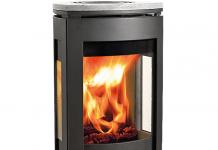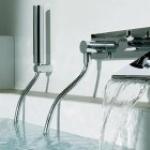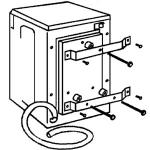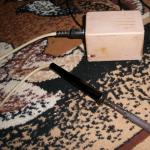Or it is difficult to use a metal stove as the main heating device even in a small house, because you will have to add firewood all the time, day and night, which is extremely inconvenient, and not every firebox is designed for constant operation. However, a small fireplace or stove can be used to support the main heating system on particularly cold days, as well as quickly warm up the house during "off-season" visits. And of course, a wood-burning fireplace is needed to create comfort and a romantic atmosphere, without which a country home loses some of its charm.
So, what does the market offer and what parameters should you pay attention to when choosing a device?
Jotul cast iron stoves: antique-style F 602 (from 30 thousand rubles). Photo: Jotul
Metal oven

Cast iron stove F 373 with a rotary body (from 90 thousand rubles). Photo: Jotul
Metal stoves, which today are often called potbelly stoves, are the cheapest option for a wood-burning fireplace. A Russian-made steel stove (brands Termofor, Vesuvius, Teplodar, Varvara, etc.) will cost 6–11 thousand rubles, and its weight will be less than 50 kg, thanks to which it will be possible to save on delivery and installation . Many potbelly stoves are equipped with burners, and some are equipped with convection devices (ventilated casings or overhead air channels) and a small viewing glass on the door, which, however, very quickly becomes overgrown with soot.

Steel stove-fireplace "Meta": "Valdai" with a power of 10 kW and a weight of 105 kg (from 289 thousand rubles) (c). All models are made of steel. Photo: "Meta"
A potbelly stove is an acceptable option only for temporary housing. It is unlikely to decorate the interior (in this article we will not talk about exclusive models from foreign companies), and its firebox is so small that you have to add firewood almost every half hour.

The convection oven (“air heating boiler”) of the Butakov series (from 11 thousand rubles) is compact and looks quite modern. The design is equipped with a replaceable grate and a retractable ash drawer. Photo: Termofor
To heat a dacha, it is wiser to purchase a convection unit that costs 13–24 thousand rubles. depending on the size. The weight of such a device varies between 55–120 kg, the rated thermal power is 10–20 kW, and the firebox volume is 80–140 liters. Such devices are equipped with a blower damper and a damper on the outlet pipe, which allows you to regulate the combustion intensity. Large models can work on one load of firewood for up to 5 hours.
The most famous designs of such stoves are “Buleryan” (nowadays its copies “Breneran” and “Valerian” are produced; the latter differs from the original in the presence of a safety casing) and “Butakov”. The “Buleryan” design is, without a doubt, more successful, since in it the convection pipes heat up “more correctly” (in the upper part much more than in the lower part) and at the same time do not eat up the combustion space. But “Butakov” looks more aesthetically pleasing than its barrel-shaped counterpart.

Steel stove-fireplace “Meta”: “Yenisei” with a power of 11 kW and a weight of 135 kg (from 35 thousand rubles) (b); "Valdai" with a power of 10 kW and a weight of 135 kg (from 35 thousand rubles) 135 kg (from 35 thousand rubles). Photo: NII KM

The Valerian stove is equipped with a safety casing; the cost of furnaces of this type is from 13 thousand rubles. Photo: Termofor
The main disadvantage of long-burning stoves is the low-temperature operating mode (smoldering), in which a significant part of the fuel does not burn, but turns into gaseous substances that are released into the street through. The secondary combustion chamber and air injectors are ineffective: the temperature in the firebox is insufficient to ignite the flue gases.

The Brio pellet stove costs several times more than its wood-burning counterparts, but is capable of operating in automatic mode. Photo: EdilKamin
- Purchase firewood in advance so that it can dry in the woodpile for at least 3-4 months. It is unprofitable to burn with raw wood (a significant part of the energy is spent on evaporation of moisture), and in addition, a lot of smoke condensate is formed.
- Do not heat the stove with scraps of chipboard, OSB and similar boards, the combustion of which releases toxic substances; some of them may penetrate the premises, and the neighbors are unlikely to thank you for the stinking smoke over the village.
- If the stove is not designed for high-temperature combustion, you should, after heating it, close the air dampers by at least a third.
- Monitor the condition of the chimney. It must be cleaned at least once a year (when operating a long-burning stove - 2–3 times a year). A soot fire in a chimney threatens to ignite wooden structures located next to the chimney.
- Ash from the hearth can be used to fertilize the soil under garden plants, with the exception of coniferous trees and shrubs that prefer acidic soil.

Steel stove-fireplace "Meta": "Baikal 8" with a nominal thermal power of 8 kW and a weight of 97 kg (from 31 thousand rubles). Photo: "Meta"
Stove-fireplace

Steel “Fire-battery” (from 14 thousand rubles). Photo: Termofor
Fireplace stoves (as well as fireplace stoves) are devices that are equipped with a door with glass and are completely ready for installation, that is, they do not require cladding. Our market offers products from Russian companies Vesuvius, Meta, EcoKamin, etc.; foreign Invicta, Supra, Tim Sistem, Vermont Castings, Jotul, ABX, etc. The fireplace stove weighs 60–100 kg, which means the device can be installed even on the second floor of a house with beamed floors.
If you have not yet decided on the installation location of the fireplace stove or the method of laying the chimney, pay attention to the fact that the design provides for two connection pipes: top and rear.

Oven AOT-06 (from 17 thousand rubles) (g), can be used for cooking. Photo: Breneran
The cost of stoves starts from 13 thousand rubles. and depends on the name of the manufacturer, dimensions, material and complexity of the design. Cast iron appliances are more expensive than steel ones (from 22 thousand rubles), are considered more resistant to high temperatures and, moreover, due to the significant (up to 10 mm) wall thickness, are able to accumulate heat. However, the vast majority of high-quality steel models (from 16 thousand rubles) are lined (finished from the inside) with fireclay blocks or plates of vermiculite (a refractory mineral), therefore they also have thermal inertia and are durable: their actual service life reaches 25 years.
Most modern fireplace stoves have a secondary combustion function; air is supplied to the flue gas combustion zone through the rear wall of the furnace (Emdip) or through injectors (Edil Kamin, La Nordica, Jotul). But to prevent additional heat from the combustion of flue gas from leaving the house through the chimney, it is necessary to provide special heat removal and heat storage elements (made of cast iron, ceramics, stone) in the lower part of the latter.

Small in size, the Ilot fireplace stove has a thermal power of 8 kW. The main features of the unit are a two-chamber firebox and a detachable decorative radiator casing. Photo: Invicta
On the market you can also find steel fireplace stoves without lining, which cost no more than 12 thousand rubles. and weigh 40–60 kg, which makes them easier to transport and install, however, the walls, made of thin (less than 3 mm) steel, can become deformed during intensive use, which leads to the destruction of welding seams.
Some or natural stone, such as soapstone. The price of this option is noticeable (from 10 thousand rubles), but the stove looks more elegant and does not emit unbearable heat, like a potbelly stove, since ceramics and potting stone absorb and dissipate part of the thermal radiation from the steel body.

Stove with ceramic finish ENBRA Pegas. Photo: ENBRA
Fireplace kit

It is believed that a vertical firebox, as in the Rais Pilar model, provides the most efficient combustion. Photo: Vladimir Grigoriev/Burda Media
For a spacious living room, it is worth purchasing a so-called fireplace set, that is, a metal firebox with a cladding made of artificial or natural stone selected by the seller. The market offers budget fireboxes from EcoKamin, Ferguss, Kratki, Nordflam, Invicta, etc., cladding from Bella Italia, Meta, etc. Compact fireplaces (the width of the finished structure is no more than 1 m, the depth is up to 70 cm) cost 27– 35 thousand rubles.
When installing a fireplace set, it is necessary to provide convection openings: inlets - in the lower part of the cladding, outlets - in the chimney casing.

The cheapest firebox for a wall-mounted fireplace with one glass. Photo: Ferlux
The factory firebox is equipped with a door with glass and air dampers (a damper is usually an additional option). Without exception, all steel models are lined with fireclay or vermiculite blocks; most have the function of afterburning flue gases. The cleanliness of the door glass is ensured by its blowing through special gaps. Pyrolytic glass cleaning, a lifting door or a convection fan increase the price of the firebox by at least one and a half times.

Most of the facings are made in the classical style: an arched base, column walls decorated with capitals, a frieze lintel and a shelf. Photo: “Fireplaces of the XXI century”

Corner models are equipped with additional heat-resistant glass in the side wall, and therefore their price is 20–30% higher. Photo: Invicta
From a design point of view, a factory fireplace set is in no way inferior to its masonry counterpart, and in some ways even surpasses it. Budget frame modules are made from lightweight concrete painted in a noble gray or yellowish color, as well as from natural sandstone and shell rock - environmentally friendly and visually attractive materials. True, they are difficult to maintain (it is problematic to wash away contaminants from the porous surface) and almost do not accumulate heat - in one and a half to two hours the fireplace will completely cool down.


Even more expensive is a firebox with a convection casing and pipes for connecting air heating hoses. Photo: Invicta
The weight of the cladding is 80–150 kg, and the entire fireplace set (excluding the chimney, the load from which can be transferred to the wall) weighs about 200–250 kg. In a house with modern slab floors, it can be installed without a foundation, but if the floors are wooden beams, they will need to be locally reinforced with support pillars.
The structure can be assembled in one day: the cladding consists of only a few modules held together with silicate glue. It is somewhat more difficult to build a decorative casing for a metal chimney pipe: its frame is assembled from galvanized metal profiles, and the cladding is made of sheet materials on a gypsum or cement base (for example, gypsum fiber board 12.5 mm thick).
Choosing a chimney for stoves and fireplaces

A stove with a ceramic finish, ENBRA Olimp, costs 2–3 times more than conventional steel models, but it looks more impressive and is also capable of accumulating heat and releasing it within 2–3 hours after the end of the fire.
You should be mentally prepared for the fact that the chimney will most likely cost more than the hearth. Of course, for a budget stove there is no need to buy expensive ones - insulated steel sandwiches costing from 1800 to 4500 rubles are quite enough. for 1 linear m, depending on the diameter, steel grade and insulation thickness.

A firebox built into the wall will not be cheap, from 45 thousand rubles, but you can save on framing. All you need is fire-resistant drywall, steel profiles for the frame and ventilation grilles. Photo: EdilKamin
It is desirable that the smoke channel be made of stainless steel grades 308, 321 according to the AISI classification or their Russian analogues, and the thickness of its walls is at least 0.7 mm (alas, pipes with walls of 0.5 mm are more common). It is allowed to lay only the first 1–2 m of pipe without insulation; then it must be insulated with a layer of stone or ceramic wool at least 30 mm thick (optimally 40–50 mm). It is advisable to equip a long-burning furnace, during operation of which a lot of condensate is formed, with a chimney made of austenitic steels (AISI 430, 439), resistant to acids.
Methods for connecting the stove to the chimney

Attachment (to the top pipe) (a) Through a tee (to the rear pipe) (b). 1 - wooden wall; 2 - oven; 3 - single-circuit chimney; 4 - condensate collector; 5 - non-flammable thermal insulation (stone or ceramic wool); 6 - thermal insulating mat (ceramic wool + asbestos cardboard); 7 - gypsum fiber sheet; 8 - insulated double-circuit chimney

Most owners of country houses need to place a heating structure for their home. Installing a stove or fireplace can help with this. This type of heating makes it possible to make your home feel cozy and comfortable.When choosing a design, the question arises: what is better, a fireplace or a stove? There is no clear answer here, because each design has its own advantages and disadvantages. But you need to make a choice, so we suggest you read this article and look at the ready-made ones.


Stoves and fireplaces - design
A home fireplace is an original part of design and interior design; it brings a cozy atmosphere and a favorable atmosphere to your home. An advantage is the ability to make a fireplace stove for your home with your own hands.
To choose the right design, you need to understand the main functions and then decide whether a fireplace or stove is better:
- — Open firebox. Mainly it has a decorative component. These types have a beautiful appearance because they make it possible to enjoy an open fire. The disadvantage of such a fireplace is its low efficiency. This type of fireplace heats up slowly and rather unevenly, which interferes with high-quality heating. This type of firebox is often used in outdoor fireplaces and stoves for country houses, since when used outdoors, the heating function is not needed, more attention is paid to the cooking function.

- — Closed firebox. Performed in a classic and familiar appearance. The hearth is closed on all sides. The material for doors and partitions is metal or tempered glass. These types of hearths are ideal for heating with a fairly high efficiency. They heat up quickly and distribute heat evenly throughout the room.

Important: if you are planning to install a fireplace for heating, then you need to pay attention to the power of the unit and its location. It must be installed in the center of the room. The best fireplace will be the one whose power matches the area of the room.
Fireplace or stove, which is better? ?
External differences play a big role, but there are also secondary features that also need to be taken into account when choosing.
Closed-type structures are the most economical, because the wood in them burns more slowly. This makes it possible to better warm up the room. In open structures, the air supply is not limited by anything, which allows the firewood to quickly burn out, and accordingly fuel consumption increases, which increases fuel costs.
Particular attention should be paid to the design of the air supply and the correctness of the smoke exhaust system. The quality of heating and removal of combustion products depends on this.
Important: compared to open types, closed ones are more expensive due to improved functionality and properties. But much will depend on the size of the chosen fireplace, installation location, material used and unit power.
Do-it-yourself stoves and fireplaces, installation and installation features
A number of rules and requirements must be adhered to in order to correctly install the structure and fully use its functionality. Quick Installation and Application Guide:
- - if you have acquired the look of an open firebox, then you need to choose a place away from windows and doors so that there are as few drafts as possible. Such a place will be safer for home and people.
- - the room must have good ventilation, this provides a regular flow of air and allows the fire to burn well.
- — in case of installation of the structure along the wall, it is necessary to perform protective thermal insulation. It is also important to make the base from non-combustible materials so that it protrudes around the stove for about a meter.
- — the unit should not be mounted near load-bearing walls; in this arrangement, the heat will go into the walls, and there will not be enough heat to warm up the room.
- — if the fireplace weighs more than 250 kg, it will be necessary to make an additional foundation.


Brick fireplace stove

Stove fireplace with oven and hob
A stove with a fireplace and stove is installed to heat a country house. A distinctive feature is exceptional heat transfer and heating efficiency. Such stoves are quite heavy, so you need to plan such a design at the stage of building a country house. It is also necessary to build a separate foundation for the furnace. Because the floor won't be able to support it.
Advice: to fully heat all rooms, the stove must be installed in the largest room. Preference is given to an island location.
Design characteristics
Fireplace stoves with a stove are the most functional; in addition to heating, they have a stove that allows you to cook food. Some types have a built-in oven. This design will be necessary for country houses where there are interruptions in electricity and gas.

Brick stoves are used mainly for heating. After heating, the heat is retained for up to 12 hours. They are economical in terms of wood consumption, not very difficult to install and are well decorated.
Brick fireplace stoves are the most versatile; they combine all the best qualities of previous types of installations. These qualities include quick heating, like a fireplace; the combustion door with glass allows you to admire the fire. A distinctive feature is the presence of two fireboxes, one made of metal and the other covered with glass.

Important: the disadvantages include the lack of air distribution; this will not allow heating more than one room.
For external decoration, ceramics or enamel are suitable. You can cook food on combined stoves and fireplaces, but they are less convenient to use.
Fireplace or stove, which is better, what to choose?
After familiarizing yourself with the features, you need to decide on the functions you need:
- — conventional stoves or fireplaces with a closed firebox are suitable for heating
- — for cooking it is better to choose an oven with a hob
- — for the beauty of the interior, you can install a fireplace with an open firebox
Based on all of the above, there is no exact answer which is better. Each type has its pros and cons. Priority is given to your requirements and the characteristics of the premises.
Which heating device should be installed in a private house? This question is asked by many users. The use of this or that fireplace should be carefully thought out, because the comfort of living of your entire family will subsequently depend on it. The system must be efficient, well-designed and suitable for the size of the heated room.
A hearth such as a fireplace is usually used in small-sized dwellings, as it is characterized by average performance and is an additional means of heating. In small-sized country houses, the hearth will be just right.
In city apartments, the installation of a traditional wood-burning device is not provided, because the fireplace requires a foundation and smoke ducts. In this case, an alternative device is suitable - electric fireplace. The design of such a sample is practically no different from a conventional device; fake firewood placed in the firebox plausibly simulates the combustion process, but the power of the structure is characterized by its high performance. Thanks to the installation, you don’t have to worry about turning off the centralized heating system; the hearth will maintain the temperature at the required high level and provide an optimal microclimate in your home. Among other things, a device of this type will increase the status of the owner, thanks to the possibility of exclusive design of the decorative space of the house.
In what cases should a heat-intensive stove be preferred? A heat-intensive stove today refers to powerful fireplace installations equipped with a water circuit. The heating system is able to fully heat several adjacent rooms of a country house, therefore it is considered the main heating device.
Modern stoves are strikingly different from the primitive brick structures of the last century. Today it is a stylish piece of furniture, equipped with an impressive cladding, with high heat transfer and accumulative capabilities.
A heat-intensive stove is installed to heat a large room, the area of which is at least eighty square meters. If you prefer this fireplace, you must think about the issue of fuel preparation and storage.
It is up to you to decide which heating device to choose, but for greater reliability, before purchasing it, you should consult with stove specialists.
The choice is not difficult - it’s quite easy to figure out what you need at the dacha - a stove or a fireplace, so that the dacha turns out to be cozy and with a twist. Spend a fun weekend cooking culinary delights over the fire, live for a while at the dacha in winter - everything can easily be arranged using a stove or fireplace in the dacha. But what exactly to choose... Let’s first understand in detail what we really want from country heating...
A stone fireplace stove for a summer cottage can be relatively heavy...
What can be achieved with a stove and fireplace in the country
If we can understand what delights we expect to get from heating, then answering the question of whether to install a stove or fireplace in the dacha will be very easy.
- Cook delicious meat and more over the fire? - Yeees….
- Admire an open flame? - it's always yes. You can watch fire and water (bewitching spectacles) endlessly. This is the main decoration of a country weekend.
- Quickly warm up the house? – for a dacha visited for the weekend, this is always yes.
- Heat the most economically, long burning? – yes, with both hands, if you live at least a few days in winter.
- Make it cheaper?, more beautiful?, faster? - as if yes...
Requirements are becoming somewhat contradictory regarding equipment. It seems that you need both a stove and a fireplace at once...
But when choosing a stove or fireplace, the main disadvantage of such heating is forgotten - the cold near the walls. Previously, in the hut, life took place near the stove, away from the cold corners. Now it is believed that an individual will not be comfortable in such a house.

Ways to overcome cold corners, windows and walls in the country
Classic modern heating involves installing heating devices along external walls, under windows - the main sources of cold, to create thermal curtains.
A stove or fireplace will require helpers - heaters under the windows. The condition is not mandatory, but desirable for residential premises.
- A fireplace or stove in the center of the house and an electric convector under the windows are optimal for small houses.
- Additional system with solid fuel (any) boiler and radiators. Recommended option for houses with an area of 70 square meters or more, if they are going to live in them in cold weather.
- Very small rooms can be insulated with reflective foil along the bottom of the outer walls - this is an economical option for redistributing the heat emitted by the central stove in a small house.
The stove is not accessible to everyone
The mass of a Russian brick kiln is from 5 tons, usually 10 tons; a separate foundation is needed. It won’t be possible to install a stove in a house without completely remodeling it. The stove is installed in such a way that it warms up all the rooms of a small building. It is not tightly connected to the partitions, since it is located on a separate foundation, which can move regardless of the movements of the house.
And creating a massive brick stove is far from easy; you still need to find a craftsman. Therefore, a real brick or stone (talcomagnesite) stove is not often found in country houses.

Advantages of the stove
The Russian stove is a very heat-intensive object, provides rare fires for large stacks of firewood, accumulates heat and is capable of maintaining a stable temperature in an insulated house for up to 24 hours. Provides the opportunity to admire an open flame. It makes excellent cooking over an open fire. High efficiency (up to 87%) and wood saving.
But it can't bake:
- to quickly warm up the house for the out of breath owners who arrived for the weekend, it warms up according to the rules - gradual fires...
Advantages of a fireplace
- Does not require a foundation - just a solid floor.
- An open flame is the best sight for a country evening.
- The option with glass can better save heat and warm up the room, with better efficiency. Its fire safety is much better; flying embers are not dangerous, like an open fireplace from which you cannot leave.
But the fireplace cannot:
- heat efficiently, economically, with high energy output. It has low efficiency - everything flies into a straight pipe, unregulated combustion, difficulty in preparing anything.
The classic fireplace was created in Europe to warm up residents during rare times of mild cold weather. Our classic fireplace has a mainly decorative role - to admire the open flame, to create special comfort, but our heat loss is too much for it.
 Metal fireplaces, due to their ease of purchase and installation, are becoming increasingly popular...
Metal fireplaces, due to their ease of purchase and installation, are becoming increasingly popular... Neither this nor that for the dacha
It turns out that the significant shortcomings of the stove (long heating time, expensive and difficult to create) and the fireplace (weak power, cold, no heat accumulation, firewood is wasted) tell us that nothing suits our dacha. What to do?
It turns out that everything has already been decided to help us empty our wallets. A fireplace stove or fireplace stove with a hob on top combines the advantages and tries to neutralize the disadvantages listed above. There is efficiency, there is some kind of heat capacity, an open flame behind the glass - please, you can cook both on the flame and on the hob, it will warm up the house quickly, since it itself is more powerful than a fireplace, and perhaps the built-in small water circuit will also allow you to connect several radiators, install possible on a durable floor (200 - 400 kg) There are many options for such a miracle device for a summer residence - choose!..

A wood stove or fireplace is a long-term investment. Therefore, determine in advance the appropriate model and its location. The heating device is selected depending on the size of the area that needs to be heated (). Will it be one room or the whole house? When choosing the power of a heating device, take into account the design features of the house, the materials used for its construction and insulation, and the climatic features of the area. It is advisable to consult with an experienced specialist in advance. We offer some universal tips.
1. Consider air circulation.
To effectively heat a room, consider air circulation: warm air rises and cold air descends.
Therefore, when choosing a stove or fireplace, think about their placement. You may need to purchase a ceiling fan or other appliances. If the fireplace is located on the first floor, and the second floor is also planned to be heated, you need to look at how warm air will be supplied there. The first option is free circulation. But then the heating will be uneven: distant rooms are colder and take longer to warm up. And if the rooms are isolated (the door is closed), they will not warm up at all, or the heating will take a very long time. The second option is to separate the hoses with warm air, when warm air from the heating device goes through the air duct and enters the room through the ventilation grille. Here you need to take into account how long the sleeves need to be pulled - if the length is long, you may need a special fan.
2. Use the entire heating volume.
When a wood stove heats up evenly, it emits infrared rays around itself. To make the most of this heat, place the stove in the middle of the room. In practice, the following types of location of the stove in the room are used:
- Location in the center of the room. Heat is dissipated 360 degrees around the oven. There are no obstacles around for the spread of heat. This is the most advantageous location of the stove.
- Location against the wall. With this installation option, heat is dissipated 180 degrees. The space in front of the oven remains free. This method is the most common.
- Corner location. Used when it is necessary to save space. This method of arrangement gives only 90 degrees from the heating sphere. For

3. If you plan to cook on the stove, take care of ease of use.
Often a wood stove is placed in the living room, since usually the kitchen, dining room and living room are connected and located nearby.

4. Remember basic safety rules.
Be sure to take fire safety requirements into account when planning the placement of the heating device. Take utmost care of the safety of your living quarters. Organize the protection of items that are not resistant to fire.

5. Think about where and how the chimney will go.
The question is especially relevant if there are living spaces above the heating device (second floor, third, attic, etc.)




















